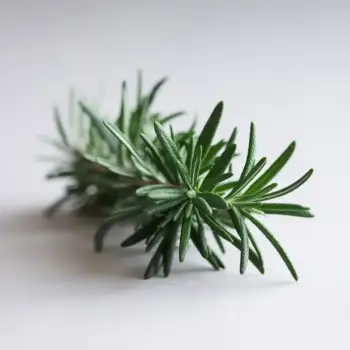Mint and Rosemary are aromatic herbs used in cooking. Mint offers a cool, refreshing taste perfect for beverages, desserts, and some meat dishes, while Rosemary provides a woodsy, robust flavor ideal for roasting meats and adding depth to savory recipes.

Mint, known for its cool and refreshing taste, is a versatile herb prominently used in drinks, desserts, and savory dishes. Its bright flavor pairs well with a myriad of ingredients, offering a burst of freshness.

Rosemary is an aromatic herb with a woodsy, evergreen scent and a pungent, slightly bitter taste. It's a staple in Mediterranean cooking, adding depth to roasted meats, soups, and breads.
Mint and Rosemary differ in taste, with Mint providing a cool, sweet profile, while Rosemary offers a warm, pine-like flavor. Texturally, Mint leaves are softer and more delicate, whereas Rosemary leaves are needle-like and tougher. In terms of source, Mint thrives in moist environments and is easy to grow, while Rosemary prefers dry, well-drained soils.

Your ultimate Recipe Box, Meal Planner, and Cooking Class all in one
Mint is a classic in beverages such as mojitos, mint juleps, and herbal teas. It imparts a fresh, soothing taste and can be muddled or used as garnish for an invigorating touch. Rosemary, while less common in drinks, can infuse cocktails or lemonades with its distinctive, herbaceous note. It's best used as a stirred-in flavor enhancer or a skewered garnish for visual appeal.
In meat dishes, Mint is often used in ground meat mixtures, lamb dishes, or as a component of fresh sauces like chutneys and relishes, providing a contrast to the richness of the meat. Rosemary's robust flavor complements beef, poultry, and particularly lamb. It can be used as part of a marinade or as a seasoning sprig during roasting to imbue the meat with a hearty flavor.
Mint shines in desserts like chocolate mint cookies, ice creams, and fruit salads, offering a refreshing counterpoint to sweet flavors. Rosemary can be used in desserts such as lemon-rosemary shortbread or peach-rosemary sorbet, where it adds a surprising twist of savory complexity.
Mint and Rosemary both offer health benefits such as anti-inflammatory properties and digestive aid.
| Nutrient | Mint ( per Ounce ) | Rosemary ( per Ounce ) |
|---|---|---|
| Fat | 0.4g | 1.7g |
| Sodium | 12mg | 26mg |
| Calcium | 56mg | 317mg |
| Protein | 1.2g | 0.7g |
| Calories | 20 | 42 |
| Carbohydrates | 3.9g | 6.8g |
Due to their distinct flavors, Mint and Rosemary are not generally interchangeable. Substitutions should be made carefully, considering the desired flavor outcome of the dish.
Mint has been traditionally used to aid in digestion due to its soothing properties, but Rosemary also has digestive benefits and can help reduce bloating and indigestion.
Mint is a perennial plant, returning year after year, while Rosemary can be perennial in warmer climates but may need to be treated as an annual in cooler regions.
Mint is best stored in the refrigerator, wrapped in a damp paper towel and placed in a plastic bag. Rosemary should be loosely wrapped in a damp paper towel and refrigerated as well.
Dried herbs are more concentrated in flavor, so you should use them in smaller quantities. Dried Mint and Rosemary can be used in cooking, but they might not be suitable for fresh applications like garnishes.